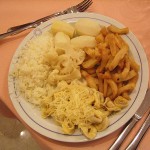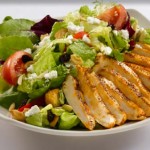To start, I’d like to point out that “clean food” will obviously mark the foods we’ve come to be told are good for you (oatmeal, vegetables, grilled chicken). “Bad food” will deal with the foods you’re supposed to stay away from (fried chicken, brownies, ice cream). Furthermore, there’s a very important distinction to be made in regards to what exactly I’m going to discuss in this article. This distinction involves putting aside the health benefits of a particular food, and focusing solely on the effects of that food in regards to an individual’s body composition. So, in plain words, do not correlate anything in this article with what’s important for your long term health, as we’re only dealing with the topic of whether there is a difference in consuming clean food/bad food when it comes to losing fat or gaining muscle (body composition). When it comes to long term health, it is highly advised to stick to clean foods and make sure they make up the majority of your diet. However, there is a very strong misconception in regards to eating bad food and how it impacts body composition, that I’d like to iron out. So let’s get to it.
Clean Food Advocates:
Many people believe that when it comes to losing fat or gaining muscle, it is imperative that you stick to clean foods for best results. That means, day in and day out you’re supposed to eat your chicken and broccoli (for example), and not stray from this diet except for a cheat meal once a week (fast food, let’s say) in order to make sure your body’s metabolism doesn’t slow down. For them, having something like ice cream, or going to burger king to grab a whopper is absolute sin. You’re not going to accomplish your goals with these types of nutritional errors where you substitute clean foods for bad food that has weaker nutritional value. To them, it’s impossible to lose fat or gain muscle when your diet is constantly plagued by bad foods.
The Actual Truth:
If we’re discussing losing fat or gaining muscle, there is absolutely nothing wrong with including bad food in your diet. Matter of fact, I’m going to go out and say that it is encouraged, as long as you understand an important concept. The only thing that matters when it comes to gaining muscle or losing fat, is the concept of maintenance calories. The article I just linked you to discusses this concept and how to calculate your maintenance calories count (the amount you spend per day, on average). Without knowing how calories work, and what you need to do in terms of managing your daily intake around your maintenance calorie count, you’re not going to get far, if anywhere at all. So make sure you look into that if you don’t know too much about it yet.
Simply put, if I require 2,500 calories to stay at my weight per day (maintenance), whether I eat grilled chicken or a whopper has no effects on my overall goal over time (losing fat, gaining muscle) because in the end, all foods are made up of calories, and if I can manage my calories, I can eat anything I want (whether that’s clean food or bad food). Let’s expand on this some more with each goal in mind. In our article, How Many Calories Per Day?, we dive into the slightly mathematical side of things and give you good ideas of where to be, in terms of calories, if you want fat loss or muscle gain. Taking numbers from that article, let’s give some examples (Using 2,000 calories as maintenance):
Fat Loss: I’ll need to eat about 1,500 calories per day in order to achieve a solid pound of fat loss per week if my maintenance is 2,000. If I have BK and my meal from there is 700 calories, I have a recommended 800 calories to go for the rest of the day. Please tell me, what impact that bad food (I’m assuming you didn’t get a grilled chicken sandwich) will have if I make sure I stay at 1,500 calories for the day? None. I get to enjoy what I was craving yet still get my results.
Muscle Gain: I’ll need to eat about 2,300 calories per day in order to give my body enough nutrients for muscle growth, yet not enough to put on significant fat along with it if my maintenance is 2,000 calories. If I go to BK, and my meal comes out to be 1,000 calories, I still have 1,300 calories to use for the rest of the day. Same principle, same result. The bad food does not impact me outside of caloric count, therefore, I will still get my results.
Now notice that these are random figures for a random maintenance count, but no matter what you are working with, the principle is the same. Food, in the end, is nothing but units of energy (calories). The laws of physics don’t change because of the type of food you eat – either more goes in than is used (surplus), or less goes in than is used (reduction). The tough part isn’t sticking to grilled chicken constantly, but making sure you’re an optimal amount over/under your maintenance calories in order to see the best results. That’s it.
However:
Not so fast, although I’ve made you super-excited that this process doesn’t confine you to the same food day in and day out, there is one very important requirement that needs to be met in order for you to accomplish your goals (fat loss/muscle gain). That important requirement refers to the macro-nutrient ratios you have (that go along with your overall caloric intake per day – in fact, make it up). Macro-nutrients are the 3 main type of nutrients that calories come from – the Protein/Carbohydrates/Fats. Everything is evaluated according to these 3, if you look at a nutritional label. Protein and Carbs are 4 calories per gram, and Fats are 9. That’s why many people think eating low fat foods will make them lose weight. As you’ve learned in this article, and will if you read that one, that’s not necessarily the case.
Proponents of the clean food concept like to point to the macro-nutrient ratios as a way to scare people into thinking bad foods cannot aid you in accomplishing your goals. Let’s say your Protein/Carb/Fat intake per day is an ideal 40/40/20 percent. They’ll say that if you take in bad foods that ratio will be quickly disrupted because a grilled chicken and oatmeal will not be able to be equaled by a whopper. Although this is true if we match things up one vs. one, let’s not be technical and stick to being flexible (which we’re all about when dismantling this whole clean food only, no bad food mentality, right?). Let’s show you how this is easily bypassed:
Taking the example above, it’s true that in a specific meal match up, a whopper loses to oatmeal and grilled chicken in the macro-nutrient ratio. However, when we’re dealing with Calories in vs. Calories out, this can simply be fixed by having a protein shake with water (to avoid carbs from juice, milk, etc.) with the whopper. Suddenly, we improve the macro-nutrient ratio of the bad food in relation to the clean food (who said supplements aren’t useful?). Although the calories, overall, will be higher with the bad food, the macro-nutrient ratio will be very similar, and if you understand the concept we’ve shown examples of earlier in the article, you’ll know you’ll have to adjust your food intake for the rest of the day to deal with the higher calorie count of the bad food. However, not a very large trade-off for being able to satisfy cravings, right?
That’s the side-effect of eating a bad food, its calorie count. You’ll almost certainly eat more calories from bad food than clean food (of equal portions), but if you apply the knowledge above, you can manage that side-effect efficiently and keep your macro-nutrient levels proper with some creativity. However, you have to keep in mind that I’m not advocating a diet filled with bad food. I’m simply letting you know that you will not lose out on your goals if you do have a meal here and there that isn’t the cleanest in the world. Bad food is acceptable, but it definitely shouldn’t be the norm. Your diet should be clean food based, with some bad food mixed in from time to time in order to satisfy your cravings and keep you happy on your journey towards your goals (which is why I mentioned that it’s actually encouraged earlier in the article). With a diet that’s got foods you like to eat instituted in it and managed properly calorie and macro-nutrient wise, you’re not going to go insane and quit, or binge. Therefore, in the long-term, you’re going to be able to accomplish your goals smooth-sailing.
Let’s be honest, nobody wants to be a robot eating the same foods every day (well, I guess those that do don’t mind), but for most people this is simply not plausible, yet they still want results. Well, you can still get results, just apply the knowledge you’ve learned here and use it to your advantage. Ice cream is allowed, fast food is allowed, just don’t make it a staple and fit it into your ratios and calories for that particular day that you have it, and you’re set. Clean food, bad food….as you can see, when it comes down to it there’s really no need for extremes. Both are acceptable, and both have their place. Just be smart about it. Good Luck!
*Note to GI Index Followers*: The GI Index has been largely discredited in terms of impacting results, and even if it played a role as important as we were once led to believe, enjoying bad food here and there will not impact your body anywhere near enough to acknowledge any type of detriment to those on a journey towards results.
Incoming search terms:
- what bad food does to your body
- is eating chicken everyday bad for you








4 Comments »